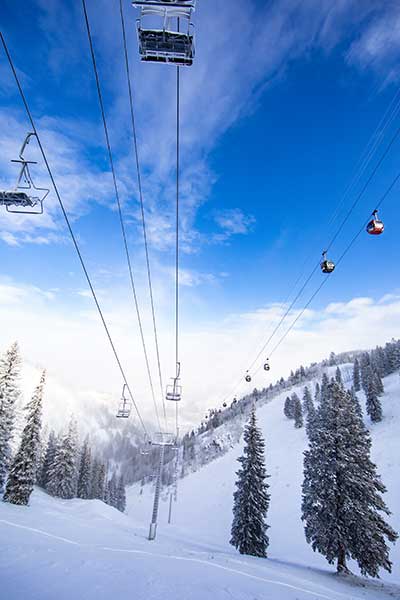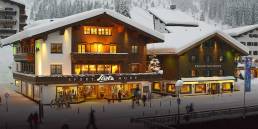Ski resorts, ski wear brands, and Protect our Winters are making fundamental changes to ensure the future of winter sports in the face of the ski industry and global warming.
Our ski industry and global warming story begins as global leaders gathered in New York for the United Nations 2019 Climate Summit in late September, Italian authorities were busy closing roads and evacuating mountain huts near the alpine town of Courmayeur in response to warnings the Planpincieux glacier (512 square miles of ice sheet located on the southern slopes of the Grandes Jorasses in the Mont Blanc massif) was in danger of collapsing. While Courmayeur’s Mayor addressed the press, attributing the “phenomena” to climate factors, Italian Premier Giuseppe Conte addressed heads of state in the United Nations General Assembly: “It is an alarm that we cannot be indifferent to.”
For those involved in the $20 billion (and that is just in the United States) snow sports industry, the news could not have come as a surprise. By now, most believe climate change is a threat to lives and livelihoods and have come to accept it as the yardstick by which impact – an oft-used word with seemingly limitless implications – is measured. After all, the ski industry and global warming problem is inextricably linked to the health of the environment. So, why are we not more united around the issue? “There is an urgent climate problem and inadequate individual and corporate action,” says Auden Schendler, Aspen Skiing Company’s (ASC) Vice President of Sustainability and the man behind “Give A Flake”, an initiative to activate engagement and influence the conversation around climate.

By any standards, ASC does more than its share to save the planet. Recognized for its progressive environmental practices and climate change advocacy, it has had both a sustainability department and environmental foundation for nearly twenty-five years. It powers the resort, as well as offsets multiples of its carbon emissions, by capturing leaking methane from a nearby coal mine, has built solar arrays, LEED-certified mountaintop restaurants and affordable housing for its employees, and invests in the local community.
Encouragingly, ASC is not alone. In recent years, ski resorts across the country have followed suit – from Jackson Hole, Snowbird and Squaw Valley to Crystal Mountain and Sugarbush. In 2017, Taos Ski Valley became the first ski resort to be designated as a Benefit Corporation (B Corp), a certification awarded to businesses that meet the highest standards of verified social and environmental performance, public transparency, and legal accountability to balance profit and purpose. Over the past few years, Taos has also been working hard to reduce its carbon footprint – from upgrading its snowmaking machines to developing a geothermal heating system for its new hotel, The Blake. It has vowed to reduce its emissions twenty percent by 2020. It even restored the Rio Hondo riverfront within the valley and has partnered with The Nature Conservancy on broader conservation efforts.
“Things corporates do are good business, but they’re not a climate solution,” says Schendler. “Snow sports can do a lot more to move the needle.” When it comes to the ski industry and global warming issue, long-time activist, Schendler believes the industry has the potential to be a “big lever” – maybe even bigger than the NRA – if only it could be weaponized.
“The industry is huge and could be a powerful lobby group aginst the ski industry and global warming,” he says. “By nature, though, it’s full of people who want to escape politics and policies.”

Professional snowboarder Jeremy Jones is an exception to that theory. Over the years, he has ventured into some of the world’s most remote mountain ranges in search of uncharted lines, camping for weeks while waiting for the perfect day and time to ride.
“I started seeing changes to the snow, which coincided with what the scientists were telling us,” says Jones. “As an industry-based around snow, I saw we weren’t doing enough. I wasn’t an expert, but as an athlete, I knew how the media worked. I remember writing on a piece of paper ‘we can protect our winters’, found a guy to do the website and an app, found a lawyer and formed the organization.”
Launched in 2007, Protect Our Winters (PoW) has grown into the leading advocacy group for the winter sports community. In reality, they work with less than 4% (collectively) of the companies and individuals involved – what Jones refers to as a loud, vocal minority.
“Our tactic is to motivate people on the sidelines,” says Jones. “It’s what we call a base-plus method. We’ve gotten very tactical and know where we need to win.”

Anyone hitting the slopes this winter can be tactical, as well. Starting with your performance and extreme weather kit, which may not be simpatico with sustainable materials and values (hint: most is not) – it might be time for an upgrade.
“There is an inherent hypocrisy that exists within an industry that sells us plastics and laminations to help us thrive in the outdoors,” says Bob Sheard, co- Founder (with his wife Sophie Phillips-
Sheard) of leading outdoor brand and marketing agency Fresh Britain. Having worked with some of the industry’s biggest brands, including Salomon, Gore and Arc’teryx, Sheard sees this as an opportunity – i.e., we have a chance to shift to a low carbon economy – and is quick to add it is something brands and consumers are embracing.
“There is a growing awareness about what’s right and wrong when it comes to consumption,” he says. “We’ve all felt the pull of a fantastic product that makes us feel more confident and able, and now we want to do that with a clear conscience. That is the new hygiene.”
Patagonia, Burton and The North Face, all undisputed bellwethers for corporate social responsibility, have for decades, strived to reduce their environmental footprint. But to Schendler’s point, perhaps it is their engagement in environmental action and advocacy that has had the most impact and influence on the industry. From the formation of associations like the Sustainable Apparel Coalition, which now includes some fifty members who, collectively, produce nearly a third of all clothing and footwear manufactured globally, to Patagonia’s recent decision to close its stores and offices to “join in solidarity with the youth activists peacefully striking for climate action”, these companies are inspiring a bevy of next-gen brands to seize the “opportunity”.
For the founders of outdoor clothing company Picture Organic, total committed responsibility for the environment and sustainability-driven eco-design were non-negotiables from the get-go. They use 100% recycled, organic, or responsibly sourced materials. They track every inch of its supply chain from manufacturing through packaging and shipping and are aggressively working to lower their carbon footprint through the use of renewable energy. Ideologically, the company is emphatic about mitigating climate change (here’s where Patagonia’s legacy, in particular, kicks in) and continually rallies its community of employees, consumers and sponsored athletes in the fight. “If you’re not an activist, you are nothing,” says Julien Durant, who, along with business partners Jérémy Rochette and Vincent Andre founded Picture Organic Clothing eleven years ago. “You don’t have to be a hypocrite to be in business. We can change the way we do business and then change the way people consume. People will decide with their wallet which brands will die and which will live.”
To battle the ski industry and global warming problem, the innovative use of biomaterials in products like its Harvest jacket (35% of next year’s collection will be made from materials derived from sugarcane) to investing to help its suppliers transition to renewable energy, tethering mission and business strategy has paid off for Picture, which received B Corp certification in late November. Equal parts fashion statement and ideological imprimatur, the brand is de rigueur in Europe in particular, a cult favorite with young and old alike. Founded some twenty-five years ago, Swedish brand Houdini has also evolved into a cult favorite, loved equally for its high performance “clean” designs, earthy color palette, and disruptive approach. It manufactures its products with a Scandinavian sensibility, using materials that are 100% recycled, recyclable, renewable, biodegradable or Bluesign certified – quality comfort, texture and fit made entirely from waste.
Predominantly led by women, Houdini is a rare species in an industry traditionally dominated by men. Though a global brand, it behaves more like an outlier, most notably by rejecting the fashion industry’s modus operandi of creating consumer anxiety around the new – for Houdini, it is all about inclusivity. The company is also the first-ever to publish a corporate sustainability report based upon the Planetary Boundaries Framework – a holistic concept focused on the nine processes and systems that regulate Earth’s stability and resilience.
“We are the Patagonia of Europe,” says Eva Karlsson, Houdini’s CEO. “We’re different, of course, but have the same goals.
“We believe the way to be sustainable is not to compromise on beauty or performance, but without nature, there is no business for us.”
Interestingly, by adhering to the principles of a circular economy, Houdini is democratizing winter sports fashion, making it accessible to rich, poor, experts and beginners through a reuse platform for second-hand styles, as well as a rental platform where customers pay a “per-use” fee. As of last year, the company has also run a pilot subscription service as another alternative to owning, allowing customers to pay a monthly fee for access to a library of clothes with the option to switch garments whenever they want. Plans for strategically located recycling units, as well as a broader take-back system, are also in the works.

“Most brands do couture and ready to wear, meaning they have to compromise somewhere to make things more affordable,” says Karlsson. “By having rental and reuse, we will not compromise our original products and we will reach more consumers.”
Being small and independent helps as does being owned (mostly) by its mission-aligned employees. Without pressure from outside investors who might be driving the business for quick growth and higher margins, Houdini has been able to take a long-term perspective – a strategy that Alessandro “Sandy” Marchi, the Founder of Opera Skis, not only relates to, but says aligns nicely with his long-held tenet that everything we do must be 100% – not 1% – for the planet.
“The responsibility of the investors and the manufacturer is to produce responsibly, and create high performing goods using circular economy materials,” says Marchi. “The model is not customer-driven, but in the end will help capture market share.”
Opera hopes to realize its commitment to zero-waste within the next five years in an effort to combat the ski industry and global warming issue. They are collaborating with regional universities and laboratories to source and develop materials that are better and less expensive than more widely used synthetics and petroleum-based products. Custom-built using state-of-the-art design and processing tools – including a proprietary Wood Evolution™ technique that allows for the use of natural wood in the top sheet – Opera’s skis and snowboards are nothing short of high-performance art.
With an ideology akin to the Slow Food Movement (the company manufactures locally and prides itself on knowing every inch of its supply chain), and a commitment to keep its carbon footprint to a minimum (it has no intention of globally distributing its products) it is difficult to decide if Opera is cuttingedge or old-fashioned – given its next sixty pairs of skis will be made with locally sourced, FSC-certified wood from Paulownia trees the company planted near the factory, probably a mixture of the two.
“In terms of measuring impact, designer ski wear brands, or snow sports industry as a whole tend to think about how they produce a product and how they deliver that product to market,” says Sheard.
“What’s also important is longevity – a long aesthetic life expectancy, as well as a long functional life expectancy.”
Though counterintuitive, longevity may well be the key to cultivating customer loyalty in a sustainability-minded world, and the weapon of choice in this yet-to-be-named revolution. After all, bespoke high quality made to last has kept brands like Chanel in business – and out of landfills.

Like Karlsson, Marchi is acutely aware he cannot build a circular economy in the absence of beauty and performance and is unwavering in his belief that the eco-friendly, sustainable materials he has chosen will perform.
“We build our products to be life-long tools,” says Marchi, who does not want customers who buy new skis or snowboards every year and has no desire to scale the company’s capacity beyond an annual production of 2,800 units (the company currently produces about 700). Instead, Marchi is banking on his eco-friendly products to not only outperform their fiberglass rivals but to age far more gracefully.
“There’s so much passion within the brands, as well as our end-users — to protect what’s there,” says Karlsson. “I think it’s imperative to show there are solutions, that there is intuitive hope in the way we portray our work that is not just about solving problems, but about realizing how to use our full potential. I mean, who wants to go down with the leader flag when there is no more snow to ski?”
“The reality is we are bigger than the extraction industry and the gun industry,” Jones says, echoing Schendler’s sentiments about the outdoor industry. “You see the power of the NRA on our elected officials, but there has never been a politician not elected because of their stance on climate.”
If Patagonia has taught us anything, it is that brands and consumers have the power to shift the paradigm. Manufacturing practices and purchasing power notwithstanding, if we are going to turn the ski industry and global warming problem around, we will need to decide with our votes, as well as our wallets.
“There is no room for deniers in office anymore,” says Jones. “We need to do everything we can and leave nothing on the table. I mean, no one is going to say we overreacted on climate.”
Related Posts
December 11, 2019
Fast Forward-Lindsey Vonn Article & Photoshoot
What Lindsey Vonn has been up to since…




